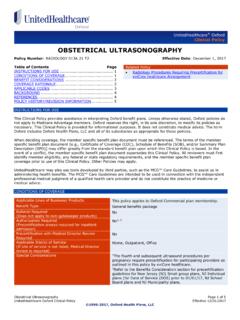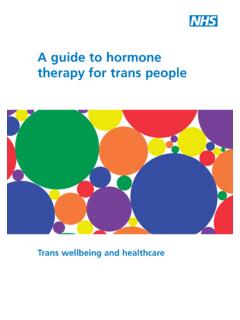Transcription of International evidence-based guideline for the assessment ...
1 International evidence-based guideline for the assessment and management of polycystic ovary syndrome 2018 Publication approvalThe guideline recommendations on pages 16 to 34 of this document were approved by the Chief Executive Officer of the National Health and Medical Research Council (NHMRC) on 2 July 2018 under section 14A of the National Health and Medical Research Council Act 1992. In approving the guideline recommendations, NHMRC considers that they meet the NHMRC standard for clinical practice guidelines. This approval is valid for a period of five is satisfied that the guideline recommendations are systematically derived, based on the identification and synthesis of the best available scientific evidence, and developed for health professionals practising in an Australian health care publication reflects the views of the authors and not necessarily the views of the Australian guideline was authored by Helena Teede, Marie Misso, Michael Costello, Anuja Dokras, Joop Laven, Lisa Moran, Terhi Piltonen and Robert Norman on behalf of the International PCOS Network in collaboration with funding, partner and collaborating organisations, see information Monash University on behalf of the NHMRC, Centre for Research Excellence in PCOS and the Australian PCOS Alliance publication: This work is copyright.
2 Apart from any use permitted under the Copyright Act 1968, no part may be reproduced by any process without written permission from Monash University Elements of this guideline were updated from the 2011 PCOS guideline and are included here with permission from the Jean Hailes Foundation for Women s Health. ISBN-13:978-0-646-98332-5 Electronic documents: This work is copyright. You may download, display, print and reproduce this material in unaltered form only (retaining this notice) for your personal, non-commercial use, or use within your organisation. Apart from any use as permitted under the Copyright Act 1968, all other rights are reserved. Copies of the guideline can be downloaded from Suggested citation: International evidence-based guideline for the assessment and management of polycystic ovary syndrome. Copyright Monash University, Melbourne Australia historyOriginal version 2011 (National PCOS guideline )Updated version August 2015 Aromatase inhibitors section updateUpdated, expanded and International current version February 2018 DisclaimerThe Centre for Research Excellence in Polycystic Ovary Syndrome (CREPCOS) research in partnership with the European Society of Human Reproduction and Embryology (ESHRE) and American Society of reproductive Medicine (ASRM), and in collaboration with professional societies and consumer advocacy groups internationally, developed the evidence-based guideline to provide evidence-based recommendations to improve the quality of healthcare, health outcomes and quality of life of women with PCOS.
3 The guideline represents the integration of the best evidence available at the time of preparation, multidisciplinary, International clinical perspectives and patient preferences. In the absence of scientific evidence in PCOS, evidence from the general population was considered and a consensus between the engaged stakeholders was obtained. The aim of evidenced-based guideline is to aid healthcare professionals and consumers in decisions about appropriate and effective care, although recommendations are generalised and application requires consideration of individual patient characteristics and preferences. All recommendations and practice points need to be considered in the context of regional to the guideline does not guarantee a successful or specific outcome in an individual or override the healthcare professional s clinical judgment or patient preference in diagnosis and treatment of individual patients. Ultimately, healthcare professionals must make their own clinical decisions on a case-by-case basis, using their clinical judgment, knowledge, and expertise, and taking into account the condition, circumstances, and perspectives of the individual patient, in consultation with that patient and/or the guardian or carer.
4 The guideline partners make no warranty, express or implied, regarding the guideline and specifically excludes any warranties of merchantability and fitness for a particular use or purpose. The partners shall not be liable for direct, indirect, special, incidental, or consequential damages related to the use of the information contained herein. While the partners have made every effort to compile accurate current information, however we cannot guarantee the correctness, completeness, and accuracy of the guideline in every respect at all times. Guidelines do not necessarily represent the views of all clinicians that are members of the partner and collaborating societies. The information provided in this document does not constitute business, medical or other professional advice, and is subject to evidence-based guideline for the assessment and management of polycystic ovary syndrome 20181 AcknowledgmentsWe gratefully acknowledge the contribution of our engaged, funding, partner and collaborating organisations:1 The Australian National Health and Medical Research Council (NHMRC) through the funded Centre for Research Excellence in Polycystic Ovary Syndrome (CREPCOS) (APP1078444) and the members of this Centre who led and co-ordinated this International guideline effort 2 Our partner organisations which co-funded the guideline : American Society for reproductive Medicine (ASRM) European Society of Human Reproduction and Embryology (ESHRE)3 Our collaborating and engaged societies and consumer groups.
5 Androgen Excess and Polycystic Ovary Syndrome Society (AEPCOS) American Paediatric Endocrine Society Asia Pacific Paediatric Endocrine Society (APPES) Asia Pacific Initiative on Reproduction (ASPIRE) Australasian Paediatric Endocrine Group (APEG) Australian Diabetes Society (ADS) British Fertility Society (BFS) Canadian Society of Endocrinology and Metabolism (CSEM) Dietitians Association Australia (DAA) Endocrine Society (US Endo) Endocrine Society Australia (ESA) European Society of Endocrinology (ESE) European Society for Paediatric Endocrinology (ESPE) Exercise and Sports Science Australia (ESSA) Federation of Obstetric and Gynaecological Societies of India (FOGSI) Fertility Society Australia (FSA) International Society of Endocrinology (ISE) International Federation of Fertility Societies (IFFS) International Federation of Gynaecology and Obstetrics (FIGO) Italian Society of Gynaecology and Obstetrics (SIGO) Japanese Society for Paediatric Endocrinology (JSPE) Jean Hailes for Women's Health (Translation partner) Latin American Society for Paediatric Endocrinology (SLEP) Nordic Federation of Societies of Obstetrics and Gynaecology (NFOG) PCOS Challenge Inc.
6 The National Polycystic Ovary Syndrome Association The PCOS Society (India) Paediatric Endocrine Society (PES) Polycystic Ovary Syndrome Association of Australia (POSAA) Royal Australasian College of Physicians (RACP) Royal Australian College of General Practitioners (RACGP) Royal Australian and New Zealand College of Obstetricians and Gynaecologists (RANZCOG) Royal College of Obstetricians and Gynaecologists (RCOG) Society for Endocrinology (United Kingdom) South African Society of Gynaecology and Obstetrics (SASOG) Verity UK Victorian Assisted reproductive Technology Association (VARTA)Other relevant organisations are welcome to partner in guideline translation once 2 ContentsPublication approval Publication history Disclaimer Authorship Copyright information Acknowledgments 1 Contents 2 Preface 4 Abstract 5 Executive Summary 6 Context and background 6 guideline purpose and aims 7 Key principles 8 Patient population 8 Setting and audience 8 Governance 8 guideline Development Groups 10 Prioritised clinical questions 10 What the guideline does not address 10 guideline development methods 10 Community and consumer engagement 11 Funding 12 Editorial
7 Independence and disclosures of interest 12 guideline translation 12 Interpreting the recommendations 14 Recommendations Summary 16 Chapter One Screening, diagnostic assessment , risk assessment and life-stage Irregular cycles and ovulatory dysfunction Biochemical hyperandrogenism Clinical hyperandrogenism Ultrasound and polycystic ovarian morphology Anti-M llerian Hormone (AMH) Ethnic variation Menopause life-stage Cardiovascular disease Gestational diabetes, impaired glucose tolerance and type 2 diabetes Obstructive sleep apnea Endometrial cancer 55 Chapter Two Prevalence, screening, diagnostic assessment and treatment of emotional wellbeing Quality of life Depressive and anxiety symptoms, screening and treatment Psychosexual function Body image Eating disorders and disordered eating Information resources, models of care, cultural and linguistic considerations 69 Chapter Three Lifestyle Effectiveness of lifestyle interventions Behavioural interventions Dietary interventions Exercise interventions Obesity and weight assessment 82 CONTENTS International evidence-based guideline for the assessment and management of polycystic ovary syndrome 20183 Chapter Four Pharmacological treatment for non-fertility indications Pharmacological treatment principles in PCOS Combined Oral Contraceptive Pills and & combined oral contraceptive pills in combination with other agents Metformin Anti-obesity pharmacological agents Anti-androgen pharmacological agents Inositol 99 Chapter Five assessment and treatment of infertility assessment of factors that may affect fertility.
8 Treatment response or pregnancy outcomes Tubal patency testing Ovulation induction principles Letrozole Clomiphene citrate and/or metformin Gonadotrophins Anti-obesity agents Laparoscopic ovarian surgery Bariatric surgery In-vitro fertilisation Gonadotropin releasing hormone protocol Trigger type Choice of FSH Exogenous luteinizing hormone (LH) Adjunct metformin In-vitro maturation 123 Chapter Six guideline development methods 124 Governance and process 125 Multidisciplinary International guideline development groups 125 Clinical question development and prioritisation 126 Outcome prioritisation using the GRADE method 129 Adaptation of existing evidence-based guidelines 130 Evidence reviews to answer the clinical questions 130 Quality (certainty) of the body of evidence using GRADE evidence profiles 133 Formulation of recommendations using the GRADE evidence to decision framework 134 Public consultation 136 External review 136 Scheduled review and update of the guideline 136 Dissemination and implementation 137 References 141 Appendix I: Project board 173 Appendix II: International Advisory Panel 174 Appendix III: guideline development groups 175 guideline development technical team members 180 Paediatric GDG panel membership 180 Appendix IV: Berlin Questionnaire 1997 IONSLEEP 181 Appendix V: Abbreviations and acronyms 182 Appendix VI: Glossary 183 Appendix VII: evidence-based guideline development pathway 188 Appendix VIII: 190 Algorithm 1: Screening, diagnostic assessment , risk assessment and life-stage 191 Algorithm 2.
9 Prevalence, screening, diagnostic assessment and treatment of emotional wellbeing 193 Algorithm 3: Lifestyle 194 Algorithm 4: Pharmacological treatment for non-fertility indications 195 Algorithm 5: assessment and treatment of infertility 196 CONTENTS 4 Preface This International evidence-based guideline for the assessment and management of Polycystic Ovary Syndrome (PCOS), designed to provide clear information to assist clinical decision making and support optimal patient care, is the culmination of the work of over 3000 health professionals and consumers internationally. The vast majority gave of their time and expertise voluntarily. We fully appreciate the considerable contributions of the guideline development group members and particularly of the project board (Appendix I), International advisory board (Appendix II) and most importantly to the chairs, co-chairs and members of the International , multidisciplinary guideline development groups (Appendix III).
10 Acknowledgement goes to the tireless efforts, commitment, dedication and drive of the Project Manager, Ms Linda Downes, Evidence lead Dr Marie Misso, Translation lead Dr Rhonda Garad, Project Board Chair, Professor Robert Norman, and the guideline evidence team for their contribution. We acknowledge the enthusiasm and engagement of the health professionals and women affected by PCOS, our partners European Society of Human Reproduction and Embryology and American Society for reproductive Medicine and our collaborating and engaged professional societies and consumer advocacy and support organisations internationally. These stakeholders have guided scope, identification of gaps and needs, prioritisation of clinical questions and outcomes of importance, review of evidence, formulations of recommendations and the guideline , as well as development and implementation of the dissemination and translation program. Professor Helena Teede MBBS, PhD, FRACP, , National Health and Medical Research Council Centre of Excellence in PCOS International PCOS guideline lead Director, Monash Centre for Health Research and Implementation (MCHRI),Monash Public Health and Medicine, Monash UniversityExecutive Director, Mo












